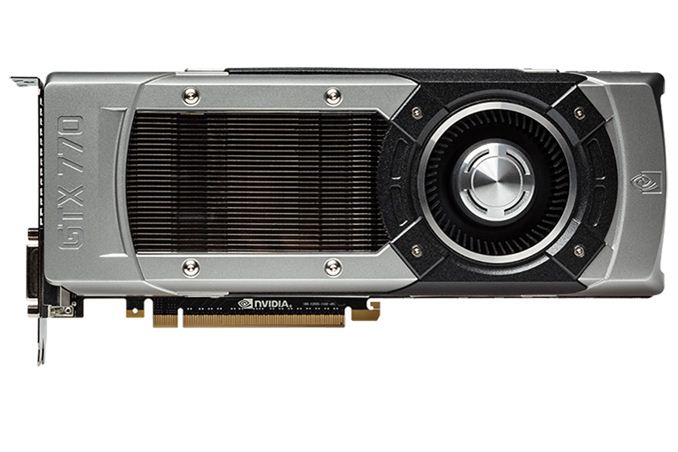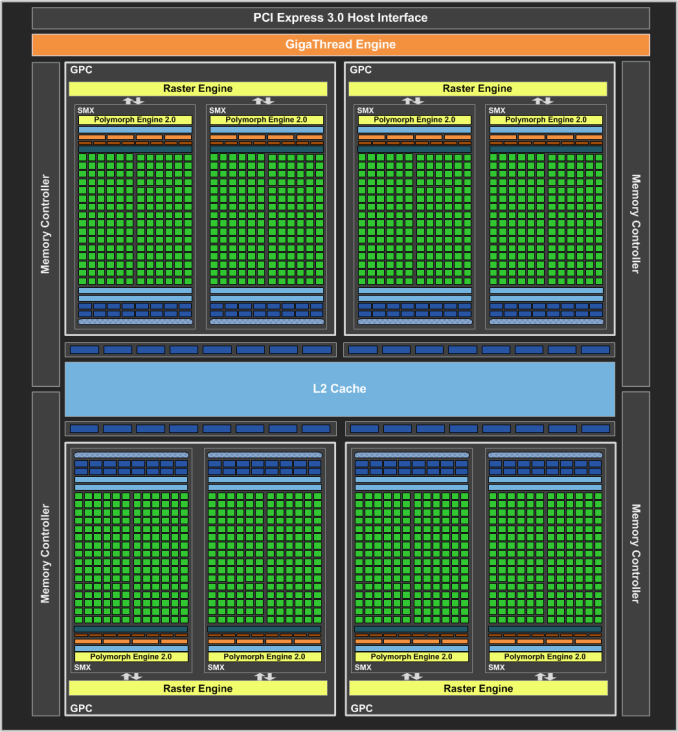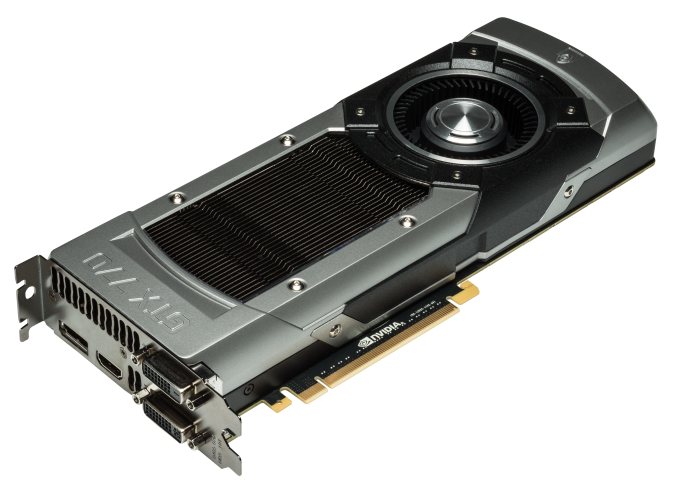NVIDIA GeForce GTX 770 Review: The $400 Fight
by Ryan Smith on May 30, 2013 9:00 AM EST
As spring gets ready to roll over to summer, last week we saw the first phase of NVIDIA’s annual desktop product line refresh, with the launch of the GeForce GTX 780. Based on a cut-down GK110 GPU, the GTX 780 was by most metrics a Titan Mini, offering a significant performance boost for a mid-generation part, albeit a part that forwent the usual $500 price tier in the process. With the launch of GTX 780 the stage has been set for the rest of the GeForce 700 series refresh, and NVIDIA is wasting no time on getting to the next part in their lineup. So what’s up next? GeForce GTX 770, of course.
In our closing thoughts on the GTX 780, we ended on the subject of what NVIDIA would do for a GTX 770. Without a new mid/high-end GPU on the horizon, NVIDIA has instead gone to incremental adjustments for their 2013 refreshes, GTX 780 being a prime example through its use of a cut-down GK110, something that has always been the most logical choice for the company. But any potential GTX 770 is far more nebulous, as both a 3rd tier GK110 part and a top-tier GK104 part could conceivably fill the role just as well. With the launch of the GTX 770 now upon us we finally have the answer to that question, and the answer is that NVIDIA has taken the GK104 option.
What is GTX 770 then? GTX 770 is essentially GTX 680 on steroids. Higher core clockspeeds and memory clockspeeds give it performance exceeding GTX 680, while higher voltages and a higher TDP allow it to clock higher and for it to matter. As a result GTX 770 is still very much a product cut from the same cloth as GTX 680, but as a fastest GK104 card yet it is a potent successor to the outgoing GTX 670.
| GTX 770 | GTX 680 | GTX 670 | GTX 570 | |
| Stream Processors | 1536 | 1536 | 1344 | 480 |
| Texture Units | 128 | 128 | 112 | 60 |
| ROPs | 32 | 32 | 32 | 40 |
| Core Clock | 1046MHz | 1006MHz | 915MHz | 732MHz |
| Shader Clock | N/A | N/A | N/A | 1464MHz |
| Boost Clock | 1085MHz | 1058MHz | 980MHz | N/A |
| Memory Clock | 7GHz GDDR5 | 6GHz GDDR5 | 6GHz GDDR5 | 3.8GHz GDDR5 |
| Memory Bus Width | 256-bit | 256-bit | 256-bit | 320-bit |
| VRAM | 2GB | 2GB | 2GB | 1.25GB |
| FP64 | 1/24 FP32 | 1/24 FP32 | 1/24 FP32 | 1/8 FP32 |
| TDP | 230W | 195W | 170W | 219W |
| Transistor Count | 3.5B | 3.5B | 3.5B | 3B |
| Manufacturing Process | TSMC 28nm | TSMC 28nm | TSMC 28nm | TSMC 40nm |
| Launch Price | $399 | $499 | $399 | $349 |
With GTX 780 based on GK110, GTX 770 gets to be the flagship GK104 based video card for this generation. At the same time to further differentiate it from the outgoing GTX 680, NVIDIA has essentially given GK104 their own version of the GHz Edition treatment. With higher clockspeeds, a new turbo boost mechanism (GPU Boost 2.0), and a higher power limit, GTX 770 is GK104 pushed to its limit.
The end result is that we’re looking at a fully enabled GK104 part – all 32 ROPs and 8 SMXes are present – clocked at some very high clockspeeds. GTX 770’s base clock is set at 1046MHz and its boost clock is at 1085MHz, a 40MHz (4%) and 27MHz (3%) increase respectively. This alone doesn’t amount to much, but GTX 770 is also the first desktop GK104 part to implement GPU Boost 2.0, which further min-maxes NVIDIA’s clockspeeds. As a result being that GTX 770 reaches its highest clocks more often, making the effective clockspeed increase greater than 4%.
But the more breathtaking change will be found in GTX 770’s memory configuration. With GTX 680 already shipping at 6GHz there’s only one way for NVIDIA to go – up – so that’s where they’ve gone. GTX 770 ships with 7GHz GDDR5, making this the very first product to do so. This gives GTX 770 nearly 17% more memory bandwidth than GTX 680, an important increase for the card as the 256bit memory bus means that NVIDIA has no memory bandwidth to spare for GTX 770’s higher GPU throughput.
We’ve talked in length about GDDR5 memory controllers before, noting that 7GHz has always been the planned limit for GDDR5. Good GDDR5 memory can hit it easily enough, but GPU memory controllers and memory buses are another matter. After faltering with the Fermi generation NVIDIA was able to hit 6GHz on their first shot with GK104, and now with their second shot and a new PCB NVIDIA is ready to certify GK104 as 7GHz capable. Given all the teething GDDR5 has gone through on both sides of the aisle, this is a small but impressive achievement for NVIDIA.
Moving on, between the higher GPU clockspeeds, higher memory clockspeeds, and the introduction of GPU Boost 2.0, NVIDIA is also giving GTX 770 a hearty increase in TDP, for both the benefits and drawbacks that brings. GTX 770’s TDP is 230W versus GTX 680’s 195W, and due to GPU Boost 2.0 the old 170W “power target” concept is going away entirely, so in some cases the difference in effective power consumption is going to be closer to 60W. Like GTX 780, this higher TDP is a natural consequence of pushing out a faster part based on the same manufacturing process and architecture, and we expect this to be the same story across the board for all of the GeForce 700 series parts. At the same time however we’d point out that the 230W TDP higher than usual for a sub-300mm2 GPU, reflecting the fact that NVIDIA really is pushing GK104 to its limit here.
Along with differentiating the GTX 770 from the GTX 680, these small improvements also serve to further separate the GTX 770 from the GTX 670, which because it’s based on the same GPU, makes this to some extent necessary to provide the necessary performance gains to justify the mid-generation refresh. As GTX 670 was a lower clocked part with only 7 of 8 SMXes enabled, the performance difference between it and the GTX 770 ends up being due to a combination of those two factors. With a clockspeed difference of 131MHz (14%), the theoretical performance difference between the two cards stands at about 30% for shading/texturing, 14% for ROP throughput, and of course 17% for memory bandwidth. This won’t be nearly enough to justify replacing a GTX 670 with a GTX 770, but it makes it a respectable increase as a mid-generation part, and very enticing for those GTX 470 and GTX 570 owners on 2-3 year upgrade cycles.
Moving on to the launch and pricing, unlike the GTX 780 last week, NVIDIA is being far more aggressive on pricing with the GTX 770, catching even us by surprise. From a performance standpoint the GTX 770 already makes the GTX 680 redundant, and if the performance doesn’t do it then the launch price of $399 will. $399 also happens to be the same price the GTX 670 launched at, so this is a fairly straightforward spec-bump in that respect.
At the same time NVIDIA is going to be phasing out the GTX 680 and GTX 670, so while these parts may see some sales to clear our inventory there won’t be any kind of official price cut. As such other than their lower TDPs these parts are essentially redundant at the moment.
For this reason NVIDIA’s real competition will be from AMD, with the $399 price tag putting the GTX 770 somewhere between AMD’s Radeon HD 7970 and Radeon HD 7970 GHz Edition. The price of the GTX 770 is going to be closer to the former while the performance is going to be closer to the latter, which will put AMD in a tight spot. AMD’s saving throw here will be their game bundles; NVIDIA isn’t bundling anything with the GTX 770, while the 7970 cards will come with AMD’s huge 4 game Level Up with Never Settle Reloaded bundle.
Finally, today’s launch is going to be a hard launch just like GTX 780 last week. Furthermore NVIDIA’s partners will be shipping semi-custom cards right at launch, and in fact we aren’t expecting to see any reference cards for sale in North America. This means there will be a great variety among cards, but not necessarily much in the way of consistency.
| May 2013 GPU Pricing Comparison | |||||
| AMD | Price | NVIDIA | |||
| AMD Radeon HD 7990 | $1000 | GeForce GTX Titan/GTX 690 | |||
| $650 | GeForce GTX 780 | ||||
| Radeon HD 7970 GHz Edition | $440 | GeForce GTX 680 | |||
| $400 | GeForce GTX 770 | ||||
| Radeon HD 7970 | $380 | ||||
| $350 | GeForce GTX 670 | ||||
| Radeon HD 7950 | $300 | ||||





_box_card_thumb.png)











117 Comments
View All Comments
khanov - Friday, May 31, 2013 - link
*sigh*You failed again.
khanov - Friday, May 31, 2013 - link
Sorry dude, that wasn't aimed at you. Anand your comments system has a mind of its own.If I reply to xyz I sort of expect my reply to be below xyz's comment and not inserted randomly in to the comments list.
chizow - Thursday, May 30, 2013 - link
Once again, a year late, but still a nice card. The updated cooler and higher memory clocks are impressive, but the max Boost clock was achievable on "FTW" type binned GTX 680s in the past.I guess this is Nvidia's "Gigahertz Edition", basically an overclocked SKU to bring parity in the performance midrange market.
Homeles - Thursday, May 30, 2013 - link
How in the world is this card a year late? Nvidia was still winning at this time, one year ago. Now they have not one, not two, but three single GPU cards that are on parity or are faster than the 7970 GE. Nvidia is in a far better position than they were with their GTX 500 series.chizow - Thursday, May 30, 2013 - link
Full GK104 should've been GTX 670 and below from the outset, as Nvidia initially planned. That's why it's a year late, at this price point anyways.Also, AMD reached parity with Nvidia's GTX 680 last year with the 7970GE launch in June/July, which then distanced itself by 5-10% with the Never Settle Drivers in Sept/Oct last year.
Now that the GTX 770 has launched and is ~10% faster than the 680, it again, reaches parity with the 7970GE.
JPForums - Thursday, May 30, 2013 - link
I thought the 104/114 series was historically reserved for the x60, while the 100/110 series was meant for the x70/x80 chips. Thus this new highend GK104 model should have been a 760Ti. GK110 should have maxed out at the 780 and the 770 should have been the paired down model. If they really had to have a Titan, it should have been a DPFP uncapped 780 (so they got that almost right).Of course the prices should have been the usual highend price points and not the massive price jumps they are currently pushing. Sure you can justify the price with the current performance relative to the previous generation, but if we always did that, the high end cards would get perpetually more expensive as the performance of each new generation of cards would justify a price hike over the previous generation. In reality, these prices are the unfortunate result of a lack of competition. Of course not all companies handle lack of competition the same way. nVidia has shown that, when uncontested, they will jack introductory prices into the stratosphere (8800 Ultra - $800-1000, $650 - GTX280, Titan/GTX780 - $1000/$650). Under normal competitive conditions, the top single GPU card from either nVidia or AMD/ATi of each generation comes in at $500. In similarly uncontested situations AMD/ATi has proven to be much less abusive to their customers (7970 - $550, 5870 - $400). Granted the relatively low price of the Dual GPU GTX295 probably kept the 5870s price in check until the GTX400 series launched, but at that point there was a significant difference in stability between single and dual GPU cards. Now I must mention, lest anyone gets the wrong idea, that AMD/ATi was probably only taking this route because marketshare/mindshare was more important to them than profit margins. Nonetheless, the facts remain.
chizow - Thursday, May 30, 2013 - link
I agree with virtually everything you said, although I never really had a problem with Nvidia jumping GK104 up a SKU to the x70 range. The performance was certainly there especially relative to last-gen performance and full GK104 also beat AMD's best offering at the time.The problem I had was Nvidia's decision to turn this 2nd tier ASIC into their flagship and subsequently, hold off on launching their true flagship ASIC a full year AND charge $1000 (and later, $650) for it.
All events predicated on the fact AMD launched 7970 at flagship prices when it really didn't deserve the asking price. Tahiti launch set the stage for Nvidia to not only undercut AMD pricing but to beat them in performance as well with only their 2nd tier chip.
JPForums - Thursday, May 30, 2013 - link
True, the 7970 could definitely be considered overpriced when it launched, but it was the undisputed performance champ until nVidia finally launched the GTX680 to bring back competition. Though, this begs the question, was the 7970 really this underperforming, or was the GK104 simply larger and faster (relatively speaking) than midrange chips in the past. Given that the GK104 die size is smaller than the GTS250, GTX460, GTX555 die sizes, I'd say larger is out. That said, they removed a lot of compute resources to get the gaming performance they were targeting, so faster might hold some weight.The 7000 series sudden proficiency in compute combined with the equally sudden removal of compute focus in the GTX600 series meant the 7970 would need to be far larger to maintain equivalent performance. Given the fact that Tahiti XT (352mm) was much closer to the size of GK104 (294mm) than GK110 (561mm), the 7970 should probably be considered a mid-weight. That is to say I can conclude that Tahiti XT was under performing (in games) AND GK104 was an overachiever. So the question becomes, is compute capabilities important enough to sacrifice gaming performance that a year ago likely would have clocked in closer to the GTX780 (GTX775 class?) for compute performance that in many cases exceeds Titan, but gaming performance roughly on par with a GTX680?
JlHADJOE - Friday, May 31, 2013 - link
IMO AMD's initial, higher price on the 7970 was justified. People forget that it was a much bigger chip than the 6970, with a 384-bit bus instead of 256. Any 384-bit part is effectively big, IMO. Same size as the 580, and now the Titan and 780.The fault here IMO goes right back to AMD's marketing division. If they hadn't stupidly went from 5870 to 6970, then people might have noticed that Tahiti was in fact a bigger part than its two immediate predecessors, and properly deserving of the 7900-series naming.
EJS1980 - Thursday, May 30, 2013 - link
Pretty much this /I\I
I